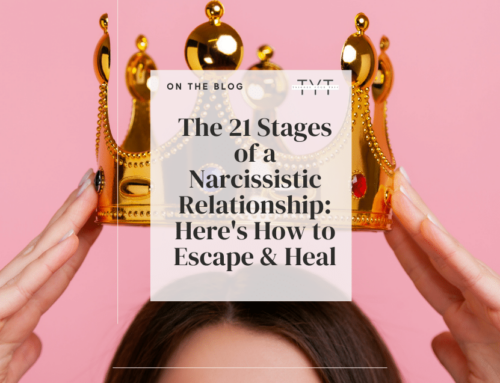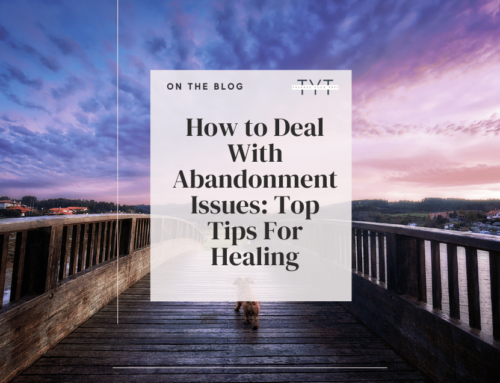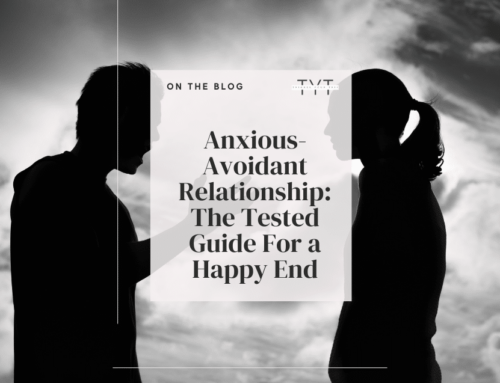I once found myself entangled in a relationship that started beautifully but slowly began to blur the lines between support and suffocation. Learning the hard way, I discovered the significance of relationship boundaries. This journey unveiled the delicate art of balancing closeness with individuality and trust with autonomy. Spending time in solitude while staying true to myself and my desires, even if my partner has different preferences and opinions, was something that took me years to build.
This article delves into the subtle nuances of setting and respecting boundaries from personal experiences, client stories, and expert insights. Join me as we explore how the lines we draw in our relationships ultimately pave the way for healthier, happier connections.
What Are Healthy Boundaries?
Healthy boundaries are the essential framework that defines the limits and parameters within any relationship, whether with friends, family, partners, or colleagues. These healthy boundaries encompass emotional, physical, and psychological dimensions, safeguarding our personal autonomy and well-being while fostering respectful and harmonious interactions.
They act as a form of self-care, reflecting our values, purpose, needs, and limits.
Healthy boundaries empower individuals to communicate their expectations clearly, making navigating conflicts easier, honoring personal space, and maintaining a sense of identity within relationships. They provide a comfortable space to express thoughts, feelings, and desires without fear of judgment or infringement.
Maintaining healthy boundaries involves both assertiveness and empathy. It means recognizing when to say “yes” or “no” based on what aligns with our values and emotional capacity, even if it might disappoint others. Simultaneously, respecting others’ boundaries is equally vital, demonstrating an understanding of their autonomy and limits. Healthy boundaries prevent emotional burnout, resentment, and codependency by fostering balanced, reciprocal relationships.
They contribute to a climate of mutual respect, trust, and empathy, allowing individuals to grow independently and together. Healthy boundaries are the cornerstone of any thriving relationship, promoting personal well-being and fostering genuine connections built on understanding and respect.
Related: How Hyper-Independence Can Signify Trauma (& 5 Ways To Cope)
Examples of Healthy Boundaries in Relationships
Here are some examples of healthy boundaries:
- Personal Space: Requesting alone time to recharge without feeling guilty or invaded.
- Emotional Expression: Communicating feelings openly and honestly without fearing judgment or criticism.
- Work-Life Balance: Setting limits on work-related activities outside of working hours to maintain personal time in the relationship and prevent burnout.
- Social Interactions: Choosing when and where to socialize, declining invitations without feeling obligated, and leaving social situations if they become uncomfortable.
- Physical Touch: Clearly expressing comfort levels with physical contact and respecting others’ boundaries in this regard.
- Digital Communication: Designating specific times for responding to messages and emails instead of being constantly available.
- Financial Boundaries: Discussing and establishing financial boundaries within relationships, such as shared expenses and personal spending.
- Personal Beliefs: Politely declining discussions or debates about sensitive topics in which one prefers not to engage.
- Intimacy: Clearly communicating one’s comfort level with various forms of intimacy in the relationship and ensuring both partners are on the same page.
- Feedback and Criticism: Offering constructive feedback and receiving criticism openly while limiting hurtful or disrespectful comments.
- Time Management: Prioritizing commitments and responsibilities for each side to avoid overloading yourself with too many tasks.
- Family Dynamics: Setting boundaries with family members to establish independence and define the level of involvement in personal decisions regarding the relationship.
- Support: Providing help and support to your partner while recognizing when it’s necessary to step back to prioritize your own well-being.
- Online Presence: Managing online privacy settings and choosing what personal information both partners feel comfortable sharing on social media platforms about the relationship.
- Friendship Balance: Balancing time spent with friends and maintaining individual hobbies and pursuits.
These examples illustrate how healthy boundaries empower individuals to maintain their well-being, express themselves authentically, and cultivate positive relationships built on respect and understanding.
Related: The 35 Premarital Counseling Questions to Ask Before Committing
Examples of Unhealthy Boundaries
- Physical Aggression: Using physical force or violence to control or manipulate others.
- Constant Criticism: Habitually criticizing or demeaning someone’s appearance, actions, or choices.
- Overbearing Control: Dictating and micromanaging every aspect of your partner’s life, leaving them little room for autonomy.
- Excessive Jealousy: Demonstrating possessiveness and jealousy to the extent that it becomes controlling and invasive.
- Ignoring Consent: Disregarding someone’s refusal or lack of consent, whether in physical interactions or other aspects of a relationship.
- Exploitation: Taking advantage of someone’s vulnerability, resources, or emotions for personal gain.
- Gaslighting: Manipulating someone into questioning their own perception of reality, making them doubt their feelings and experiences.
- Emotional Blackmail: Using threats or emotional manipulation to get what you want, regardless of the other person’s well-being.
- Isolation: Attempting to cut someone off from their friends, family, or support network, leaving them isolated and dependent.
- Bullying and Intimidation: Using fear, intimidation, or humiliation to exert control over your partner.
These examples underline the harmful effects of unhealthy relationship boundaries on individuals’ self-esteem, emotional health, and overall well-being.
Related: Reactive Abuse & Narcissism: What Is It & How To Deal With It
The Subtle Difference Between Healthy And Unhealthy Boundaries
The distinction between healthy and unhealthy boundaries lies in how they shape relationships and impact individuals’ well-being. Healthy boundaries are rooted in self-respect, fostering a sense of autonomy while promoting genuine connection. They enable open communication, allowing individuals to express their needs, preferences, and emotions without fear of judgment.
Healthy boundaries encourage mutual respect and reciprocity, acknowledging that each person’s limits and values deserve consideration. On the other hand, unhealthy boundaries often emerge from control, manipulation, or a lack of consideration for others’ autonomy. They can lead to feelings of suffocation, resentment, and emotional turmoil.
Unhealthy boundaries may involve crossing personal lines, ignoring consent, or failing to establish a balance between independence and interdependence. The impact of unhealthy boundaries can be profound, eroding trust, self-esteem, and the overall quality of relationships. Recognizing this subtle difference is vital for creating and maintaining relationships that thrive on respect, understanding, and shared growth.
It’s about striking a harmonious equilibrium where both individuals feel empowered and valued, fostering an environment of emotional safety and mutual support.
Related: Emotional Permanence Explained & 5 Top Tips on How to Cope
Different Categories of Healthy Relationship Boundaries
Sexual boundaries
Sexual boundaries clearly state one’s comfort level and limits regarding physical intimacy within a romantic relationship, ensuring that both partners understand and respect each other’s boundaries and consent.
Emotional boundaries
Emotional boundaries express the need for personal space and time to process feelings independently, communicating that while sharing emotions is important, maintaining individual emotional well-being is equally valued in a relationship.
Physical boundaries
Setting healthy boundaries regarding physical space means kindly asking your partner not to touch or invade personal belongings without permission and establishing a clear line between personal comfort and the need for respect in physical interactions.
Financial boundaries
Financial boundaries in a relationship have to do with mutually deciding on a division of expenses while maintaining individual financial independence for personal purchases. This ensures transparency, prevents financial strain, and respects each person’s autonomy within the partnership.
Spiritual boundaries
Spiritual boundaries in a relationship is openly discussing and respecting differing beliefs, allowing each person the freedom to practice their spirituality without imposing or criticizing, and fostering an environment where both partners feel accepted and understood in their spiritual paths.
Related: 10 Must-Read Spiritual Awakening Books To Transform Your Life
5 Ways of Setting Boundaries in Healthy Relationships
Communicate your own feelings openly
Communicating feelings openly is pivotal for establishing firm boundaries as it cultivates clarity and mutual understanding. Sharing emotions provides insight into one’s comfort zones, limits, and needs. When feelings are expressed, our partners understand how their actions impact us, promoting empathy and respect.
Open communication minimizes assumptions and prevents misunderstandings, fostering a foundation of trust. It empowers individuals to assert themselves and maintain self-respect, ensuring that boundaries are recognized and upheld.
By sharing feelings openly, relationships are nurtured with authenticity and honesty, creating an environment where boundaries are acknowledged and honored, leading to healthier dynamics and stronger connections.
Related: How to Fix Anxious Attachment Style: The 9 Top Tested Strategies
Use more “I” than “You” Language
Using more “I” than “you” language is vital for setting boundaries as it promotes assertiveness and minimizes defensiveness. “I” statements focus on expressing personal feelings and needs, conveying your perspective without blaming or accusing.
This approach encourages open dialogue, preventing the other person from becoming defensive or resistant. It emphasizes self-responsibility and empowers individuals to take control of their emotions and boundaries.
In contrast, “you” language may trigger feelings of blame, leading to communication breakdown. By using “I” language, boundaries are communicated with clarity, respect, and a greater chance of being understood and accepted.
Stay firm and value your personal boundaries
Staying firm and valuing personal boundaries is essential for fostering healthy relationships, as it signifies self-respect and communicates that your needs and limits are vital to the partnership.
By maintaining boundaries, individuals ensure their emotional well-being, preventing feelings of resentment or being taken for granted. Respecting personal boundaries reflects mutual respect and empathy, creating a foundation of trust and understanding. It encourages open communication, allowing both partners to express themselves freely while maintaining a sense of autonomy.
Ultimately, upholding personal boundaries enhances the quality of the relationship, enabling growth, harmony, and the longevity of a meaningful and fulfilling partnership.
Maintain mutual respect
Maintaining mutual respect is crucial for setting firm boundaries and nurturing a healthy relationship, as it establishes a foundation of equality and acknowledgment of each person’s autonomy. When boundaries are respected, it demonstrates care for each other’s emotional well-being and personal space.
Care creates an atmosphere where open communication thrives, allowing both partners to express their needs and limits without fear of judgment. In addition, mutual respect fosters empathy and understanding, preventing the crossing of lines and ensuring that both individuals feel valued.
Ultimately, it cultivates an environment of trust, where boundaries are upheld and each partner’s identity is honored, contributing to a resilient and fulfilling relationship.
Claim your personal space
Claiming personal space preserves individuality and emotional well-being. As mentioned multiple times, solitude allows time for introspection and self-care, preventing emotional exhaustion.
By defining personal boundaries, you communicate your needs and teach your partner how to respect your autonomy – and that self-respect fosters confidence in expressing desires and limits. Personal space serves as a retreat for recharging, enhancing mental clarity and emotional resilience.
By claiming this space, you establish a clear message that your needs matter, ensuring a healthier balance between engagement and solitude within relationships and building a foundation of respect and harmony.
Learn from your past relationships
Learning from past experiences is instrumental in setting clear boundaries as it offers valuable insights into what works and what doesn’t. Reflecting on previous situations where you could not maintain healthy boundaries helps you identify patterns, triggers, and areas needing improvement.
By analyzing these moments, you gain self-awareness about your comfort zones, needs, and communication style. This knowledge equips you to communicate and set healthy emotional boundaries more effectively, making them explicit and non-negotiable.
Past experiences guide you in recognizing red flags and practicing assertiveness, preventing history from repeating itself. Ultimately, drawing wisdom from the past empowers you to set boundaries, safeguard your well-being and nurture healthier relationships.
Related: The 150 Top Shadow Work Prompts to Unblock Your Potential
Relationship Boundaries List (Examples & Categories)
This handy relationship boundaries checklist will help you better understand healthy boundaries in relationships and how they can affect your mental health.
Physical intimacy boundaries
- Hand-Holding: Expressing a preference for or against holding hands in public or private settings.
- Kissing: Establishing comfort levels regarding the frequency and intensity of kisses on lips and cheeks.
- Hugging: Communicating how often and under what circumstances hugging is welcome, considering factors like emotional state and familiarity.
- Cuddling: Discussing boundaries around cuddling, spooning, or physical closeness when spending time together.
- Sexual Activity: Clearly defining boundaries related to sexual activities, indicating what is acceptable and what isn’t at different stages of the relationship.
- Personal Touches: Addressing your comfort with casual touches like shoulder taps, arm around the waist, or playful nudges.
- Physical Play: Set boundaries on playful interactions like tickling, wrestling, or roughhousing to avoid discomfort or injury.
- PDA (Public Displays of Affection): Expressing preferences for the level of physical intimacy displayed in public, such as holding hands versus more intimate gestures.
Related: Fearful Avoidant Attachment: 7 Signs of Craving & Fearing Love
Emotional intimacy boundaries
- Sharing Vulnerabilities: Choosing what personal struggles, fears, or experiences to share with someone based on trust and comfort.
- Past Traumas: Deciding when and how to disclose past traumas, ensuring it aligns with your emotional readiness and the strength of the relationship.
- Personal Goals: Sharing aspirations and dreams while maintaining a sense of independence and individual growth.
- Family Matters: Establishing how much information about family dynamics or personal issues to disclose to others.
- Negative Energy: Letting others know when discussing certain topics or engaging in negative conversations becomes emotionally draining.
Related: Why Do I Get Attached So Easily? The Main Reasons & 7 Tips
Communication boundaries
- Conflict Resolution: Agreeing on respectful ways to address disagreements and conflicts, maintaining emotional safety, and avoiding harmful tactics.
- Time Alone: Communicating the need for personal space and time for self-reflection without feeling obligated to share every emotional moment.
- Listening and Support: Being clear about the kind of support you seek when sharing feelings, whether it’s advice, empathy, or just a listening ear.
- Independence: Maintaining a sense of individual identity and personal hobbies or interests, even within close relationships.
- Future Plans: Discussing long-term goals and plans while considering individual aspirations and the potential for shared commitments.
Related: Dismissive Avoidant Attachment: The Push & Pull That Destroys
Boundaries to family members
- Communication Boundaries: Let family members know that you appreciate open communication but prefer to discuss certain personal matters only with your partner or close friends.
- Time Management: Establish specific times for family visits or gatherings to ensure you have adequate personal time and space for other commitments.
- Financial Boundaries: Setting limits on lending or borrowing money within the family and being clear about your willingness to help or not.
- Personal Space: Requesting that family members respect your need for privacy in certain areas of your home or refrain from entering without permission.
- Holiday Plans: Expressing your preference for alternating holiday celebrations between families or communicating that you’d like to spend certain holidays in your own way.
- Individual life: Make your family understand you are responsible for your future plans and preferences, and they are not allowed to decide things for you.
Related: 5 Weird Things Covert Narcissists Do & Ways to Protect Yourself
Setting boundaries on healthy behaviors
- Limit Contact: Reduce or limit communication with the person to minimize exposure to their negative impact on your self-esteem.
- Clear Communication: Politely assert that hurtful or critical comments are unacceptable and request that they refrain from making such remarks.
- Personal Standards: Communicate your personal standards for respectful and constructive conversations, expressing that you won’t engage in discussions that belittle or undermine you.
- Redirect Conversations: When conversations veer towards triggering topics, steer the discussion towards more positive or neutral subjects.
- Supportive Environment: Set the expectation that you will surround yourself with people who uplift and support you and distance yourself from those who do not fulfill this role.
- Boundaries on Sharing: Let them know that you will not tolerate unsolicited advice or judgments about your life choices, and assert that you will make decisions based on your own needs and preferences.
Related: The 45 Best Gaslighting Quotes to Prove It’s Their Fault
About Setting Healthy Boundaries in a Possibly Toxic Relationship
Setting healthy boundaries in a potentially toxic relationship requires careful consideration and assertive communication.
First, self-awareness is key; recognize the behaviors and situations that make you uncomfortable or drained. Second, define your limits clearly and internally before discussing them with the other person.
Lastly, choose a calm and private setting for the conversation. As mentioned above, you can use “I” statements to express your feelings and needs, focusing on how their actions affect you rather than blaming them. Be prepared for resistance or defensiveness, and stay composed, reiterating your commitment to your well-being.
Consider the possibility of seeking outside support, like therapy or counseling, to navigate the process. If the other person continuously disrespects your boundaries, be ready to enforce consequences, such as distancing yourself if necessary.
In addition, do not neglect to maintain self-care routines and engage in empowering activities. Remember that setting emotional boundaries is about preserving your mental health; if the relationship remains consistently harmful, consider the option of distancing yourself, ending it, or speaking to a mental health professional.
Prioritizing your well-being sets the tone for how you expect to be treated, fostering an environment of respect and understanding or paving the way for healthier connections in the future.
Read more: The 7 Stages of Trauma Bonding; Here’s Why You Can’t Leave
What If Your Boundary Setting Doesn’t Work?
Several scenarios can unfold if your attempts at boundary setting don’t yield the desired outcome.
Firstly, the person might not fully understand or acknowledge the importance of your boundaries, leading to continued disregard or even escalation of the behaviors you’re trying to address. Secondly, they might react defensively, feeling challenged or criticized, which can strain the relationship further.
In some cases, individuals with toxic traits might deliberately test your relationship boundaries to gauge your commitment, making it crucial to remain firm and consistent. If your boundaries are repeatedly ignored or violated, your emotional well-being could suffer, potentially leading to feelings of frustration, anxiety, and resentment.
Continuously compromising your boundaries might result in codependency or enabling unhealthy behavior, as you inadvertently send the message that your needs are secondary.
In such situations, reassessing the relationship’s overall health and weighing the pros and cons becomes essential. If the person consistently disrespects your boundaries and well-being, it might be necessary to consider limiting your interaction with them or ending the relationship altogether.
Remember that setting boundaries is about self-preservation and maintaining your emotional health through a healthy relationship. If your efforts to set healthy boundaries aren’t met with understanding and respect, it may be a sign that the relationship isn’t conducive to your growth and happiness.
In such cases, seeking support from friends, family, or mental health professionals can provide valuable perspectives and guidance as you navigate these challenging decisions.
Related: The Best 25 Journal Prompts For Mental Health to Break Trauma
Final Thoughts
In the tapestry of human connections, setting healthy boundaries in relationships emerges as a vital thread. These boundaries weave a fabric of respect, understanding, and emotional safety, allowing individuals to thrive while fostering healthier connections.
By defining limits and expressing needs, we cultivate an environment where mutual growth flourishes, conflicts are minimized, and authenticity is celebrated. Establishing these boundaries is a testament to self-worth and a commitment to nurturing relationships that uplift and empower.
In respecting both our boundaries and those of others, we craft a landscape of trust and empathy where meaningful connections can flourish.






